
Barnacles are arthropods of the subclass Cirripedia in the subphylum Crustacea. They are related to crabs and lobsters, with similar nauplius larvae. Barnacles are exclusively marine invertebrates; many species live in shallow and tidal waters. Some 2,100 species have been described.

Thecostraca is a class of marine invertebrates containing over 2,200 described species. Many species have planktonic larvae which become sessile or parasitic as adults.

The Chthamalidae are a family of chthamaloid barnacles, living entirely in intertidal/subtidal habitats, characterized by a primary shell wall of eight, six, or four plates, lacking imbricating plate whorls, and either membraneous or more rarely calcareous basis. They are not found below immediate subtidal habitats, and more likely are found in the highest tier of shallow-water barnacle fauna. They can be found in the most rigorous wave-washed locations, and some species are found in the surf zone above high tide mark, only receiving water from wave action at high tide. The family includes at least 56 recognized species.

Sessilia is an unranked clade of barnacles, comprising the barnacles without stalks, or acorn barnacles. They form a monophyletic group and are probably derived from stalked or goose barnacles. Sessilia is divided into two orders. The Verrucomorpha contain two families, Verrucidae and Neoverrucidae, and the remaining 14 families are in the order Balanomorpha.

Chthamalus is a genus of barnacles that is found along almost all non-boreal coasts of the northern hemisphere, as well as many regions in the southern hemisphere. These small barnacles have been studied in part because of the taxonomic confusion over a group of species that, by and large, are morphologically and ecologically quite similar. In recent years, molecular techniques have identified a number of cryptic species that have been subsequently confirmed by taxonomists using morphological measurements. Most recently the genus has been shown to be paraphyletic, with the genus Microeuraphia nested within Chthamalus.
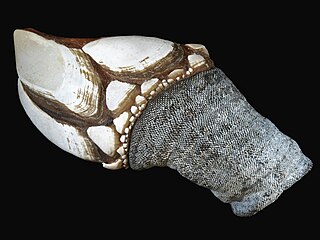
Pollicipedidae is a family of goose barnacles.

Lepadidae is a family of goose barnacles, erected by Charles Darwin in 1852. There are about five genera and more than 20 described species in Lepadidae.

Chelonibia is a genus of acorn barnacles in the family Chelonibiidae of the subphylum Crustacea. Its members are epizootic and live attached to manatees, turtles, marine molluscs, crabs and horseshoe crabs in all tropical and subtropical oceans. In a few instances, they have been found on sea snakes, alligators and inanimate substrates, but they are not found in the typical habitats of barnacles – on rocks, docks or boats.

The Chthamaloidea are a subdivision of Balanomorpha proposed by Newman and Ross to include barnacles with shell wall composed of rostrum, carina, and one to three pairs of latera, rarely supplemented with one or more whorls of basal imbricating plates. The rostrolatus enters the sheath, but rarely fuses with the rostrum, as in the three higher superfamilies. Shell plates are simple in construction, solid, and incorporate organic chitin between carbonate layers. Opercular plates are deeply interlocked, and in some genera, may become concrescent with age. Soft part morphology includes concave labrum without notch in the central part. Cirrus III more resembles Cirrus IV than II, or may be intermediate in structure. Caudal appendages present in some species.
The Catophragmidae are a family of barnacles in the superfamily Chthamaloidea with eight shell wall plates, surrounded by several whorls of imbricating plates. The basis is membranous.
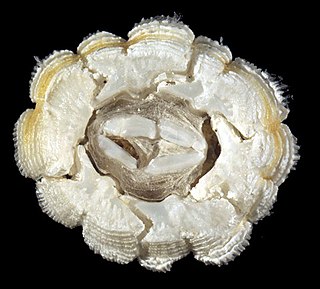
Platylepas is a genus of barnacles in the family Platylepadidae of the subphylum Crustacea.

Poecilasmatidae is a family of goose barnacles.

Scalpellomorpha is an order of acorn barnacles in the class Thecostraca. There are about 11 families in 3 superfamilies and more than 450 described species in Scalpellomorpha.
Cryptophialidae is a family of Acrothoracican barnacles in the order Cryptophialida, the sole family of the order. There are at least 2 genera and more than 20 described species in Cryptophialidae. These barnacles burrow into calcareous rocks and structures, such as limestone, shells, or corals.
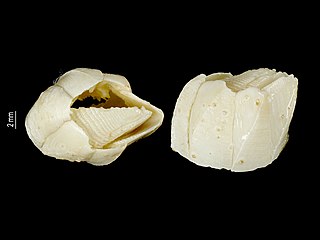
Pachylasmatidae is a family of symmetrical sessile barnacles in the order Balanomorpha. There are about 10 genera and at least 30 described species in Pachylasmatidae.

Dosima is a genus of goose barnacles in the family Lepadidae. There are at least two described species in Dosima.
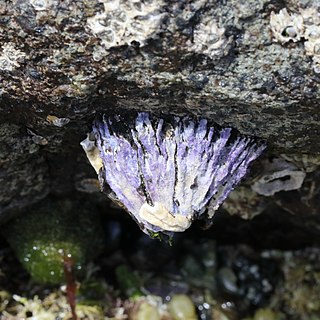
Austrobalanus is a genus of symmetrical sessile barnacles in the family Austrobalanidae, the sole genus of the family. There are at least three described species in Austrobalanus.

Brachylepadidae is an extinct family of barnacles in the order Brachylepadomorpha, the sole family in the order. There are about 7 genera and more than 20 described species in Brachylepadidae.
Iblomorpha is a small order of barnacles in the class Thecostraca. There are only two families and about eight described species in Iblomorpha. In this group we find barnacles that use calcium phosphate in their shell, and species that protect themselves against predators with poison.
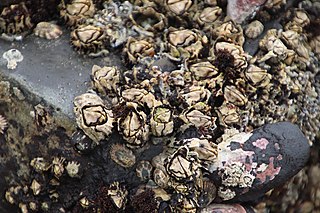
Octomeris is a genus of star barnacles in the family Chthamalidae. There are at least three described species in Octomeris.













